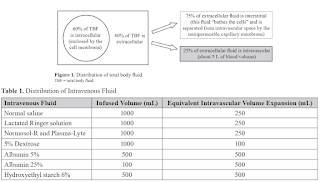Fluids
Introduction
Fluid balance is
- Estimating the input and output of fluid in the body.
- Accounting for redistribution of fluid and electrolytes outside the plasma volume.
In principle, all fluid into and out of the body should be measured and recorded on a fluid balance chart. In actual clinical practice, it is more common to express an opinion about fluid status.
Assessment of fluid status
- Signs of pulmonary or peripheral oedema
- Dry mucosa, sunken eye appearance or patient feeling thirsty
- Poor urine output (<0.5 ml/kg/hour)
- Slow capillary refill (more/less than 2 seconds)
- Blood pressure - central venous or jugular or postural hypotension
- Pulse and heart rate
- Altered conscious state
- Loss of weight over days (not weeks)
- Concentration of biochemistry
May also consider fluid challenge by passive leg raise or fluid bolus protocol.
Intravenous Fluids
Intravenous fluids are used to replace fluid losses and treat various conditions. They are categorized as crystalloids or colloids.
Crystalloids
Crystalloids contain various concentrations of sodium and/or dextrose that pass freely between semipermeable membranes. Most of the administered volume does not remain in intravascular space (inside the blood vessels), but moves into the extravascular space or interstitial space.
Crystalloids are less costly and generally have fewer adverse reactions than colloids.
E.g. Dextrose 5% (D5W), Sodium Chloride 0.9% (Normal Saline, NS), Lactated Ringer's (LR)
NOTE:
- Lactated Ringer's (historically preferred in surgery and trauma patients) and normal saline are the most common fluids used for volume resuscitation in shock states.
- The lactate in lactated Ringer solution is metabolized to bicarbonate, and it can theoretically be useful for metabolic acidosis; however, lactate metabolism is impaired during shock. Thus, lactated Ringer solution may be an ineffective source of bicarbonate.
- Dextrose 5% should not be used for fluid resuscitation because of the smaller amount of fluid that remains in the intravascular compartment, and because of rapid metabolism, it has the net effect of administering "free" water.
Colloids
Colloids are large molecules (typically protein or starch) dispersed in solutions that primarily remain in the intravascular space and generate an oncotic pressure. Colloids provide greater intravascular volume expansion than equal volumes of crystalloids, but are more expensive and have not shown clear clinical benefit over crystalloids.
E.g. Packed red blood cells, Albumin, Dextran 40, Hydroxyethyl starch
NOTE:
- Albumin should not be used for nutritional supplementation when serum albumin is low.
- Hydroxyethyl starch and dextran products have been associated with coagulopathy and kidney impairment. In addition to acute kidney injury, hydroxyethyl starch is associated with increased mortality in critically ill patients.
Summary
There is no difference between crystalloids and colloids in the time to achieve fluid resuscitation or in patient outcomes.
- Colloids have not been shown to be superior to crystalloids, and they are associated with higher cost and some adverse effects.
NOTE: The plasma osmolality is between 275 and 290 mOsm/kg.




Comments
Post a Comment